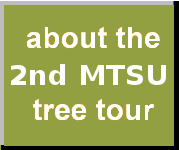
|

|

|

|
An individual instance of Quercus macrocarpa (bur oak)
Permanent unique identifier for this particular organism:
http://bioimages.vanderbilt.edu/mtsu/19
Notes:
Description
Bur oak or mossycup oak is a medium- to tall-stature deciduous tree widely distributed across the United States. Bur oak has several desirable attributes including strong branches, drought tolerance, winter hardiness, and freedom from serious insects or diseases.
On good sites, bur oak has a spreading habit with a broad crown; massive bole; and low, large branches. It is capable of reaching heights over 80 feet and individual trees up to 100 feet are found on good sites. At the far western edge of its range, heights of 50 feet can be considered about the upper limits of growth.
Uses
Windbreaks and Shelterbelts: Bur oak is recommended as a medium to tall component in windbreak and shelterbelt systems. Although modest in growth rate, especially in the western U.S., it is a strong-wooded and long lived species.
Riparian Forest Buffers: Bur oak can be used in riparian forest buffer plantings and may be a suitable substitute, depending on site conditions, for green ash (Fraxinus pennsylvanica).
Woody Draw Restoration: Bur oak is a natural component of woody draws in the central and western Great Plains.
Timber: The wood of bur oak is quite valuable and is often marketed as white oak. It is used in the manufacture of cabinets, barrels, hardwood flooring, and fence posts.
Ornamental: Bur oak makes an excellent landscape specimen, and is well suited to drought tolerant landscapes. Its strong branches make it a good choice for street trees provided it has ample space to accommodate its wide spreading basal branches.
Wildlife: Bur oak is an excellent source of food for many wildlife species including deer, turkeys, squirrels, rabbits, raccoons, and rodents. As it reaches maturity it provides roosting, loafing, and nesting for numerous species of birds.
Adaptation and Distribution
Bur oak has a large native range extending from Nova Scotia, west to Manitoba, south through Kansas to Texas, east to Alabama, and northeast to Virginia and New England. Landscape specimens can be found in many western states outside of its native range. Although favoring rich alluvial bottomland, bur oak grows well on rocky hillsides, limestone soils, droughty soils, clayey sites, and other marginal sites -- given full sun conditions. In the western United States, bur oak is considered a pioneer species and is capable of invading prairie grasslands. In the eastern Great Plains it occurs primarily along stream bottoms and stream terraces in association with green ash, boxelder (Acer negundo), and cottonwood (Populus sp.). Bur oak is, however, intolerant of flooding.
References
Scianna, J.D. (2009). Plant fact sheet for bur oak (quercus macrocarpa Michx.). Retrieved from http://plants.usda.gov/java/factSheet

|

|
|
Load database and switch to thumbnail view
Use this stable URL to link to this page:
http://bioimages.vanderbilt.edu/mtsu/19.htm
This particular organism is believed to have managed means of establishment.
This organismal entity has the scope: multicellular organism.
Identifications:
Quercus macrocarpa
Michx.
sec. Tennessee Flora 2014
common name: bur oak
family: Fagaceae
Identified 2016-03-13 by Patrick Phoebus
Location:
Alumni Drive, Rutherford County, Tennessee, US
Click on these geocoordinates to load a map showing the location: 35.8474°, -86.3655°
Coordinate uncertainty about: 10 m.
Altitude: 193 m.
Location calculated as average of its images' coordinates.
Occurrences were recorded for this particular organism on the following dates:
2016-03-13
2016-04-27
The following images document this particular organism.
Click on a thumbnail to view the image and its metadata. Load database and enable navigation by taxon and organism.
| Image | View |
|
|
whole tree (or vine) - general |
|
|
whole tree (or vine) - winter |
|
|
bark - unspecified |
|
|
bark - of a large tree |
|
|
leaf - showing orientation on twig |